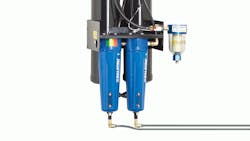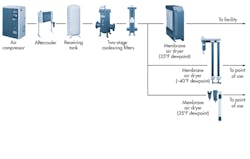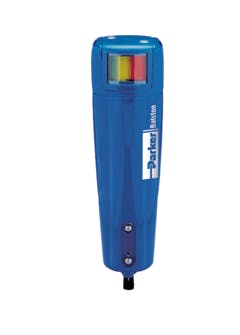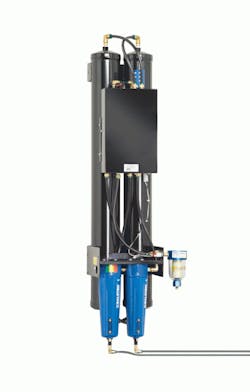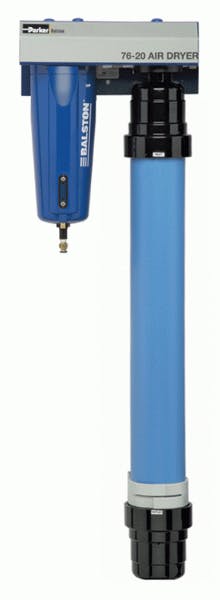Anyone who uses compressed air will, at some point, find liquid water in the air distribution system. This can be anything from a nuisance to a serious problem, depending on the application. For example, if water might corrode equipment or introduce bacteria, removing it is critical.
Compressed air typically contains water as both liquid and vapor. Because removing it carries a cost, it’s important to define how dry the air must be for a given application and specify the right equipment to produce this result. First, though, it’s helpful to understand the source of water in a system.
A compressor draws in ambient atmospheric air, which includes water vapor. Compressing the air raises its temperature, which increases the air’s vapor holding capacity as well as its dewpoint (see “Details On Dewpoint,” p. 78). Any subsequent cooling of the air (such as by an aftercooler) causes condensation. The process of “drying” compressed air can range from trapping condensed water and preventing additional condensation to removing all the water present using filters and dryers.
Compressed-air systems
To put this in context, consider the components that make up a typical air-distribution system (Fig. 1). A compressor, the heart of the system, typically compresses air to about 100 psi. Air flows from the compressor to an aftercooler, which condenses up to 75% of the water vapor. Compressed air leaving the aftercooler is saturated. Any further cooling produces condensation. For example, air could be further cooled after exiting the aftercooler if air lines are exposed to unheated rooms. This cooling below the compressed air’s dewpoint is the source of additional water that users see in their pneumatic systems.
After exiting the aftercooler, air travels to a receiver, which tends to further cool the compressed air, condensing out more liquid. Most liquid is removed through an automatic drain. However, compressed air exiting the receiver still includes liquid droplets of water, water vapor, and oil (from compressor lubricant and leaking seals), so high-efficiency coalescing filters are needed downstream from the receiver.
Coalescing filters
Coalescing filters remove contaminants and help protect downstream dryers, which are sensitive to liquid contamination. At a minimum, a single-stage, high-efficiency coalescing filter rated at 93% efficiency at 0.01 μm is adequate prefiltration for refrigerant air dryers and general pneumatic equipment.
However, two-stage, high-efficiency coalescing filters ensure complete liquid removal, assuming no further cooling beyond the filter. When instrument-quality air is needed, or a desiccant air dryer is required, it is good practice to install a two-stage filtration system near the point of use. A two-stage system has a prefilter such as a Balston Grade DX (Fig. 2), that filters out larger droplets of water and oil and a polishing filter such as a Balston Grade BX, rated 99.99% at 0.01 μm, that filters out submicron-size droplets.
Many kinds of equipment can be protected using coalescing filters alone. Yet despite upstream processing of the air, water vapor typically remains in suspension throughout the system. Sensitive equipment such as precision air-bearing tables for laser cutting or parts inspection, for example, requires extremely clean, dry air. In these cases, it’s often necessary to add an air dryer downstream from the filters.
Dryer types
A dryer removes some or all traces of water vapor before compressed air reaches the critical end-use point. Several different types are available.
Desiccant dryers deliver air at consistently low dewpoints, typically –40°F (–40°C) or less. The technology is a good choice when compressed air will be exposed to freezing conditions.
Desiccant dryers generally consist of twin towers of desiccant material that adsorbs water vapor (Fig. 3). Compressed air passes through one tower of desiccant until it’s saturated. Airflow then switches to the standby (dry) tower while the first bed is regenerated, driving captured water from the desiccant, with heat or a portion of dry air from the active tower. Heated and nonheated desiccant dryers serve the same purpose. They just use slightly different approaches.
Heated desiccant dryers require a great deal of electricity to operate. In contrast, heatless desiccant dryers don’t depend on electricity for drying, though they do consume and exhaust a small portion of the compressed air. In some cases, heatless desiccant dryers can be pneumatically controlled, which makes them suitable for explosion-proof installations.
Membrane dryers offer a range of drying capabilities to about –40°F (–40°C) dewpoint. Like desiccant dryers, this suits them for sub-freezing environments.
Membrane dryers (Fig. 4) consist of bundles of hollow membrane fibers, each permeable only to water vapor. As compressed air passes through the center of these fibers, water vapor permeates the walls of the fiber, and dry air exits from the end of the membrane dryer. The module redirects a small portion of dry air (regeneration flow) along the outer surface of the membrane fibers to carry away the moisture-laden air, and it is released harmlessly to atmosphere.
Membrane dryers have no moving parts and require no electricity, so they operate at a low cost. They only need their prefilter cartridge changed out, typically once a year. These dryers are ideal for critical end-use point applications, remote areas, and explosive environments.
Refrigerated dryers work by cooling air to low temperatures and thereby condensing out much of the water vapor. Well-designed refrigerant dryers can produce air with dewpoints to approximately 35°F (2°C). Most operate at a range of 35 to 40°F (2 to 4°C) dewpoint.
Sophisticated refrigerant dryers remove the heat from the inlet air and use it to reheat the outlet air. Dry air returns to the air line at reasonable temperatures. This process prevents condensation when air lines are exposed to cold surroundings. Self-contained refrigerant dryers use fans to cool the refrigerant condenser and automatic controls to adjust heat-exchange performance to the application requirements. These systems keep the delivered air at a constant humidity or dewpoint.
Specifying a dryer
When considering a dryer for a compressed air installation, designers can keep several guidelines in mind.
First, if compressed air will be frequently exposed to temperatures colder than ambient conditions, and instruments or equipment is sensitive to moisture, it is wise to install a dryer. A system that includes just an aftercooler and coalescing filter could lead to problems with condensation downstream from the aftercooler. The air will still be saturated with vapor, which is likely to condense when the ambient temperature is lower than the compressed-air temperature.
Details On dewpointWATER IS PRESENT in the ambient air drawn into a compressor. The amount of water in the air is called the humidity. Relative humidity is the amount of water vapor the air can hold. The air temperature dictates it. Hot air can hold more water (as vapor) than cold air. Typically, atmospheric air has about 50% of its water-vapor holding capacity for a given temperature. The proportion of vapor to the air’s maximum vapor-holding capacity is the relative humidity. Compressing air raises its temperature significantly. Higher temperatures increase the air’s vapor-holding capacity, which, in turn, reduces the relative humidity of the air. When air with a given relative humidity cools, it reaches a temperature at which it is saturated. At saturation, the relative humidity of the air is 100%, which means the air is holding as much water vapor as it can. Cooling the air beyond its dewpoint, the temperature at which the air has 100% relative humidity, condenses the water vapor. |
Next, beware of overspecifying a dryer. For example, drying the entire compressed-air supply in a plant to dewpoints below –40°F (–40°C) is wasteful and unnecessarily expensive. It is more sensible to segment the compressed-air supply by application, so each end-use point gets only the level of dryness that’s required.
Similarly, beware of underspecifying. Damage due to wet air is costly in terms of maintenance time, replacement parts, downtime, and lost product. Design a drying system to meet specific needs.
Leverage the “drying” effect of pressure reduction in applications that use air at pressures lower than that of the main compressed air line and that can tolerate some water vapor.
Specify membrane dryers for parts of a system that require dewpoints of 35 to 42°F (2 to 5°C) and flow rates up to 600 scfm (17 Nm3/min).
Finally, consider using membrane dryers for instrument-quality air, air exposed to freezing temperatures, and water-sensitive applications that require flow rates ranging up to 100 scfm (3 Nm3/min). Typically, compressed air with a dewpoint of –40°F (–40°C) is reasonable for these water-vapor-sensitive applications.
The right selection
Drying compressed air to the appropriate dewpoint is important. However, not all applications require ultralow dewpoint air. It is plausible to use a two-stage, high-efficiency coalescing filter system that’s installed directly at the inlet of critical end-use instruments or machines, where all liquid contaminants can be removed just prior to entering the equipment.
An air dryer or coalescing-filter system is best selected by an educated user, or with the aid of an experienced application engineer. It’s important to understand the moisture level each application can tolerate and balance the cost of the drying and filtration system with the required purity level.
ALLAN FISH is the product manager of the Parker Hannifin Corp. Filtration and Separation Division, Haverhill, Mass. For more information on air dryers from Parker’s Filtration and Separation Division, visit www.balstonfilters.com.
|
More on air-dryer fundamentals For more details about dryers for compressed air and related topics, visit the “Compressed-air dryers” section of the Hydraulics & Pneumatics Web site at bit.ly/1ih4Ktx. It’s part of the Fluid Power Basics learning resources available at www.hydraulicspneumatics.com. Other recent relevant articles covering air dryers include: • “How dry is dry enough?” bit.ly/1eaehTW • “Compact dryer handles wide-ranging applications,” bit.ly/1eiF4ff • “Hybrid air dryers offer best of both worlds,” bit.ly/LshzWA • “Use compressed air to dry your compressed air,” bit.ly/1fpS9DN |
